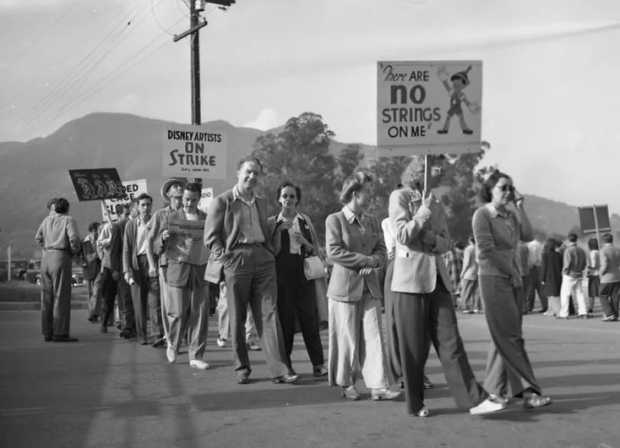Jake S. Friedman’s seminal book, 'The Disney Revolt: The Great Labor War of Animation’s Golden Age,' about an important, mostly unreported piece of Disney studio history, the 1941 animator’s strike led by the famed Art Babbitt, now available in hardbound, will arrive in a softbound version this Fall.
The hardcover version is now available on Amazon, Barnes and Noble, Goodreads, and directly through the publisher, Chicago Review Press.
Friedman uses never-before-seen research from previously lost records, including conversation transcriptions from within the studio walls, to reveal the inner machinations of the labor dispute that remains a hugely important but not well known period of animation industry history.
An overview of the work shares, “In his latest book, Friedman provides a piece of Disney history that has been unreported for 80 years. Soon after the birth of Mickey Mouse, one animator raised the Disney Studio far beyond Walt's expectations. That animator also led a union war that almost destroyed the studio. Soon, angry Disney cartoon characters graced picket signs as hundreds of animation artists went out on strike. Adding fuel to the fire was one of Al Capone's wiseguys who was seizing control of Hollywood workers and vied for the animators' union. Using never-before-seen research from previously lost records, author and historian Jake S. Friedman reveals the details behind the labor dispute that changed animation and Hollywood forever at the world's most famous studio.”
That animator was Art Babbitt, who worked for Disney throughout the 1930s up until 1941, years that saw the studio produce the seminal animated films Snow White and the Seven Dwarfs, Pinocchio, and Fantasia. Friedman writes, “…as America struggled through the Great Depression and an impending World War, labor unions spread across Hollywood. Disney fought the unions while Babbitt embraced them. Soon, angry Disney cartoon characters graced picket signs as hundreds of artists went out on strike. Adding fuel to the fire was Willie Bioff, one of Al Capone’s wiseguys, who was seizing control of Hollywood workers and vied for the animators’ union.”
He continues, “This is the untold story of American idealism, and how businessmen, artists, and the Mafia fought for control of the world’s most famous studio.”
Accolades for the book are many. Film critic and historian Leonard Maltin said, “Jake S. Friedman has done an impressive job of research, to put it mildly. Without knowing the sequence of events it’s impossible to understand how this bitter strike came about. Add to that the perceived insults, slights, and resentments and you have the stuff of great drama.”
“Author Jake S. Friedman takes us on a deep dive into Hollywood history delivered in a style that reads like a film noir page turner,” said Don Hahn, producer of Beauty and the Beast and The Lion King. “I could not put this book down.”
Oscar-winning Monsters Inc., Up, Inside Out, and Soul director Pete Docter said, “Gangsters, backroom deals, murder, and . . . cartoons? I’ve long been interested in the 1941 Disney strike, and Jake S. Friedman’s book does not disappoint. Well written and thoroughly researched - a great read!”
“Friedman’s research is comprehensive, the cast of characters succinctly etched,” said Oscar-winning filmmaker, author, and animation historian John Canemaker. “Most impressive, in the candid telling of this tale of labor relations and film art, are the all-too-human stories woven with equity throughout. Highly recommended.”
You can listen to Terry Ibele’s interview with Friedman about the book on the Animation Industry Podcast episode here.
Source: Chicago Review Press
Dan Sarto(link sends e-mail) is Publisher and Editor-in-Chief of Animation World Network.











